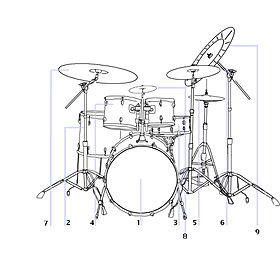Double bass drumming
 |
|
| Percussion instrument | |
|---|---|
| Classification | Percussion |
| Hornbostel–Sachs classification | 211.212.1 (Individual double-skin cylindrical drums) |
| The drum kit |
|
| Not shown |
| See also |
A bass drum, or kick drum, is a large drum that produces a note of low definite or indefinite pitch.
Bass drums are percussion instruments and vary in size and are used in several musical genres. Three major types of bass drums can be distinguished.
A bass drum is typically cylindrical with the drum's diameter much greater than the drum's depth. There is normally a struck head at both ends of the cylinder. The heads may be made of calf skin or plastic. There is normally a means of adjusting the tension either by threaded taps or by strings. Bass drums are built in a variety of sizes, but size has little to do with the volume produced by the drum. The size chosen being based on convenience and aesthetics. Music
Bass drums have many synonyms and translations, such as Gran Cassa (It), Grosse caisse (Fr), Grosse Trommel (Ger), and Bombo (Sp).
Bass drums are too large to be hand held and are always mounted in some way. The usual ways of mounting a bass drum are:
Bass drums can have a variety of strikers depending on the music:
The earliest known predecessor to the bass drum was the Turkish davul, a cylindrical drum that featured two thin heads. The heads were stretched over hoops and then attached to a narrow shell. To play this instrument, a person would strike the right side of the davul with a large wooden stick, while the left side would be struck a rod. When struck, the davul produced a sound much deeper than that of the other drums in existence. Because of this unique tone, davuls were used extensively in war and combat, where a deep and percussive sound was needed to ensure that the forces were marching in proper step with one another. The military bands of the Ottoman Janissaries in the 18th century were one of the first groups to utilize davuls in their music; Ottoman marching songs often had a heavy emphasis on percussion, and their military bands were primarily made up of davul, cymbal and kettle drum players.
Davuls were ideal for use as military instruments because of the unique way in which they could be carried. The Ottoman janissaries, for example, hung their davuls at their breasts with thick straps. This made it easier for the soldiers to carry their instruments from battle to battle. This practice does not seem to be limited to just the Ottoman Empire, however; in Egypt, drums very similar to davuls were braced with cords, which allowed the Egyptian soldiers to carry them during military movements.
The davul, however, was also used extensively in non-military music. For example, davuls were a major aspect of Turkish folk dances. In Ottoman society, davul and shawm players would perform together in groups called davul-zurnas, or drum and shawm circles.
...
Wikipedia


